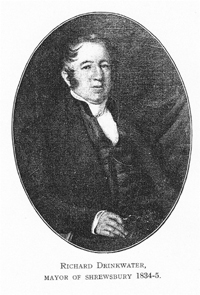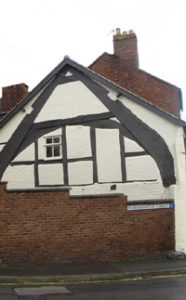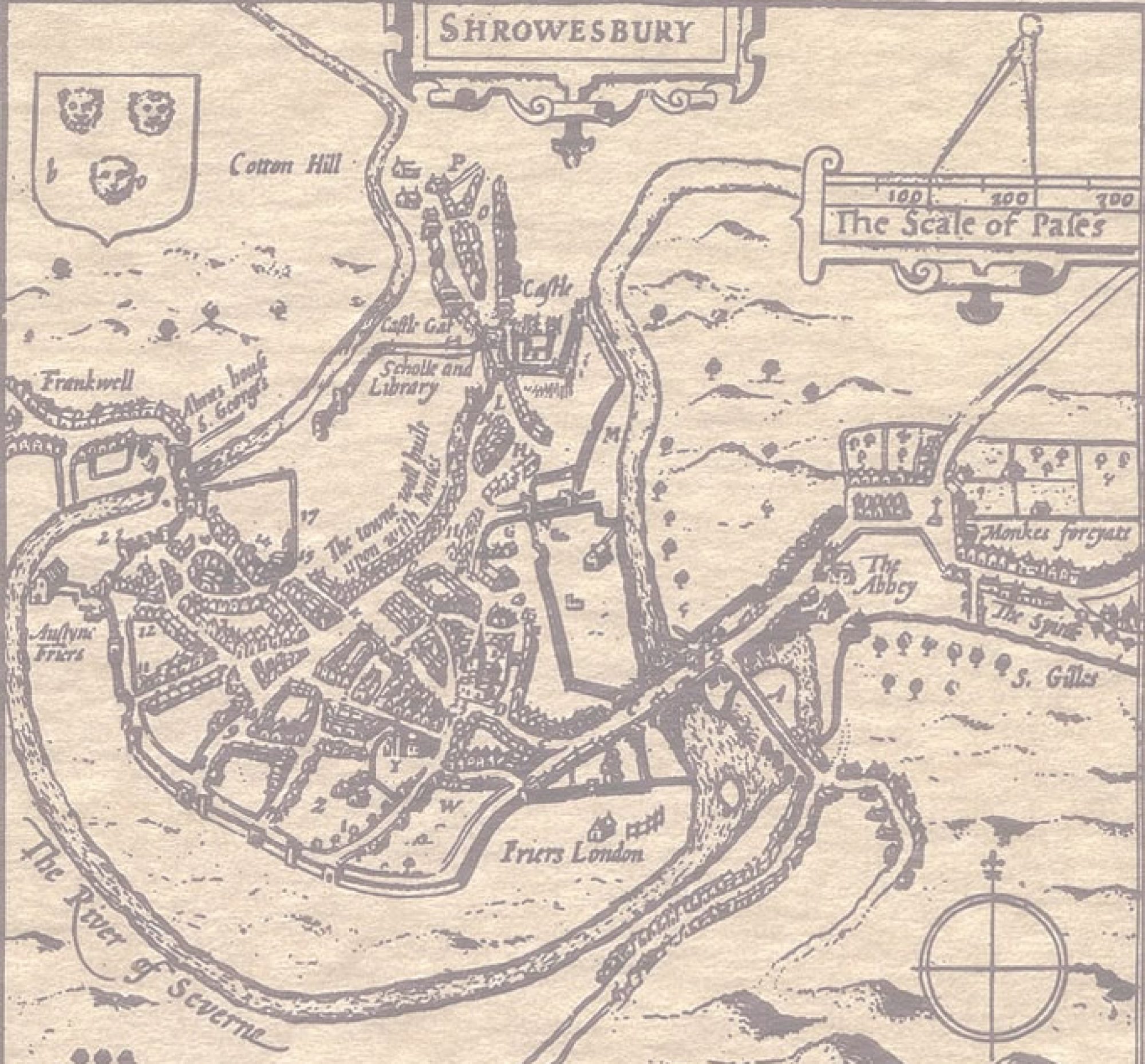
Drinkwater Street runs from what is now the Frankwell roundabout in Shrewsbury, past St George’s Church, and finishes near the River Severn. It was created in 1882 by slicing in half 92 Frankwell, whose surviving end demonstrates a rare survival of a cruck framed building. [footnote 1] This was an early type of timber framing, where the natural shape of the tree was used to form the structure of the house.
Drinkwater Street is named after the Drinkwater family, wool dealers who originally moved from Cheshire to Hodnet in the middle years of the 18th century. [footnote 2] Richard Drinkwater (1755 – 1825) prospered and came to Shrewsbury, where the family lived in Frankwell, and owned much property in the area. His son, also Richard (1785 – 1853), was a well-known and respected local figure, who was elected Mayor in 1834/35.

At that time Frankwell was in the Parish of St Chad’s, which was a very busy church – for example there were over 700 confirmations on one day in August 1828. [footnote 3] Consequently, there was a call for a new church to be built in Frankwell. Richard Drinkwater offered to give the land, and within a few days of the initial meeting in July 1827 over £540 had been donated towards the building fund. [footnote 4] It was not long, however, before there was serious opposition to the proposal. At that time St Chad’s, though nearly 40 years old, had still not paid off the money it had borrowed when the cost of building it went way over budget. The upkeep of the building was also expensive, so both interest and upkeep cost around £50,000 a year at today’s prices. [footnote 5] This was paid for by pew rents (£200-250 a year each), and church rates on property owners. In addition, landowners paid tithes of around £11-17 per acre to the Church of England, principally to support the clergy. [footnote 6] This was in addition to Poor Rates, which were also administered by the Parish. At that time the country in general, and Shrewsbury in particular, was in the depths of a depression, so any extra taxation was deeply unpopular. In addition, if the new church was intended for the poor people of Frankwell, how were they to pay up to a sixth of their annual income on pew rents?
The opponents of the new church, led by William Hazledine and William Clement among others, gained much support and called for a parish meeting. In an open letter the building committee replied in effect, ‘legally we can do what we like’ [footnote 7], which inflamed the situation more, but they did accede to a meeting in early January 1828. This turned out to be a very rowdy affair, but in the end a parish vote was allowed. [footnote 8] This resulted in a majority in favour of the new church, although the opponents claimed the vote was rigged. [footnote 9] However, the Church Commissioners did donate £2000 towards the new church, and the Committee believed that that amount, plus the sums already raised, ‘will prove amply sufficient to indemnify the parish against ordinary repairs and possible contingencies’. [footnote 10] When the new St George’s Church was consecrated in January 1832, there was also room for 460 people in the ‘free seats’, nearly twice as many as paid for their pews, which no doubt pleased those who had opposed the new building. [footnote 11]

After this inauspicious start, St George’s developed steadily, and was given a further boost with the appointment of Richard Drinkwater’s fifth son, Charles (1831 – 1923) as Vicar in 1872, a post he retained until his death, over 50 years later. He had spent 12 years in Ontario, Canada, the first 7 as a missionary. The area was then still wild and undeveloped, and he later recounted spending days at a time on horseback, and preaching one of his first sermons to a group of emancipated slaves. An outwardly brusque, but kindly man, he was an excellent preacher and good organiser, who, though scholarly, won the affection of ordinary people. [footnote 12] He was also an antiquarian, doing much valuable work transcribing and translating old documents, and doing historical research.
Footnotes
[1] www.discovershropshire.org.uk
[2] Burke,A Genealogical and Heraldic History of the Commoners of Great Britain, Volume 3, p.668ff; Anon, The Late Rev Charles Henry Drinkwater, Trans Shrops Arch Hist. Soc, 4thSeries, Vol. IX, 1923-24, p.221 ff
[3] Diary of Henry Pidgeon, 5.8.1828, SA 6001/3058
[4] Diary of Henry Pidgeon, 16.7.1827, SA 6001/3057
[5] SC Editorial, 14.12.1827; www.nationalarchives.gov.uk/currency/
[6] Letter from ‘A Farmer’, SC 29.11.1827
[7] Watton’s Cuttings, Vol. 5, p.498
[8] SC 4.1.1828
[9] SC 11.1.1828; 24.1.1828
[10] SC 29.1.1828
[11] SJ 29.1.1832
[12] Anon, The Late Rev Charles Henry Drinkwater, Trans Shrops Arch Hist. Soc, 4thSeries, Vol. IX, 1923-24, p.221 ff; SC 8.6.1823
